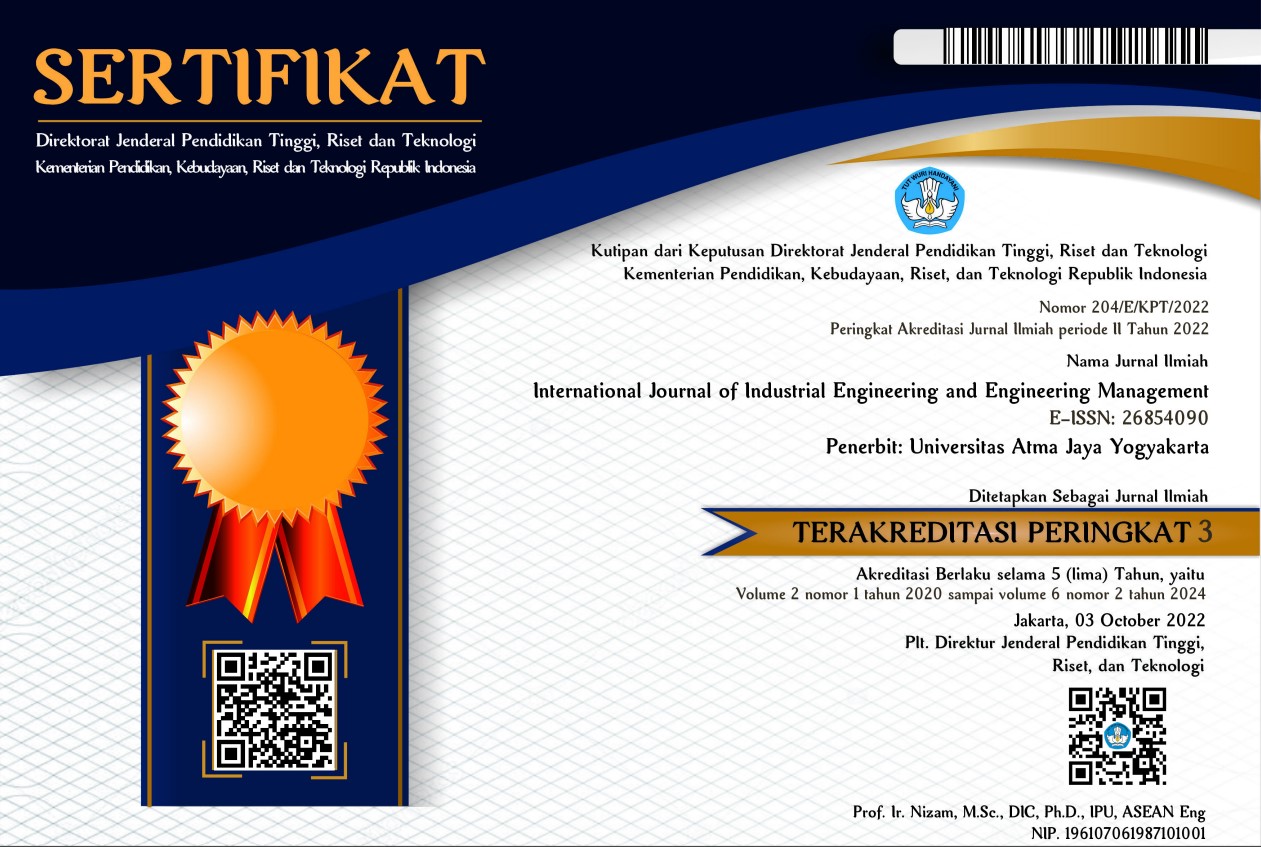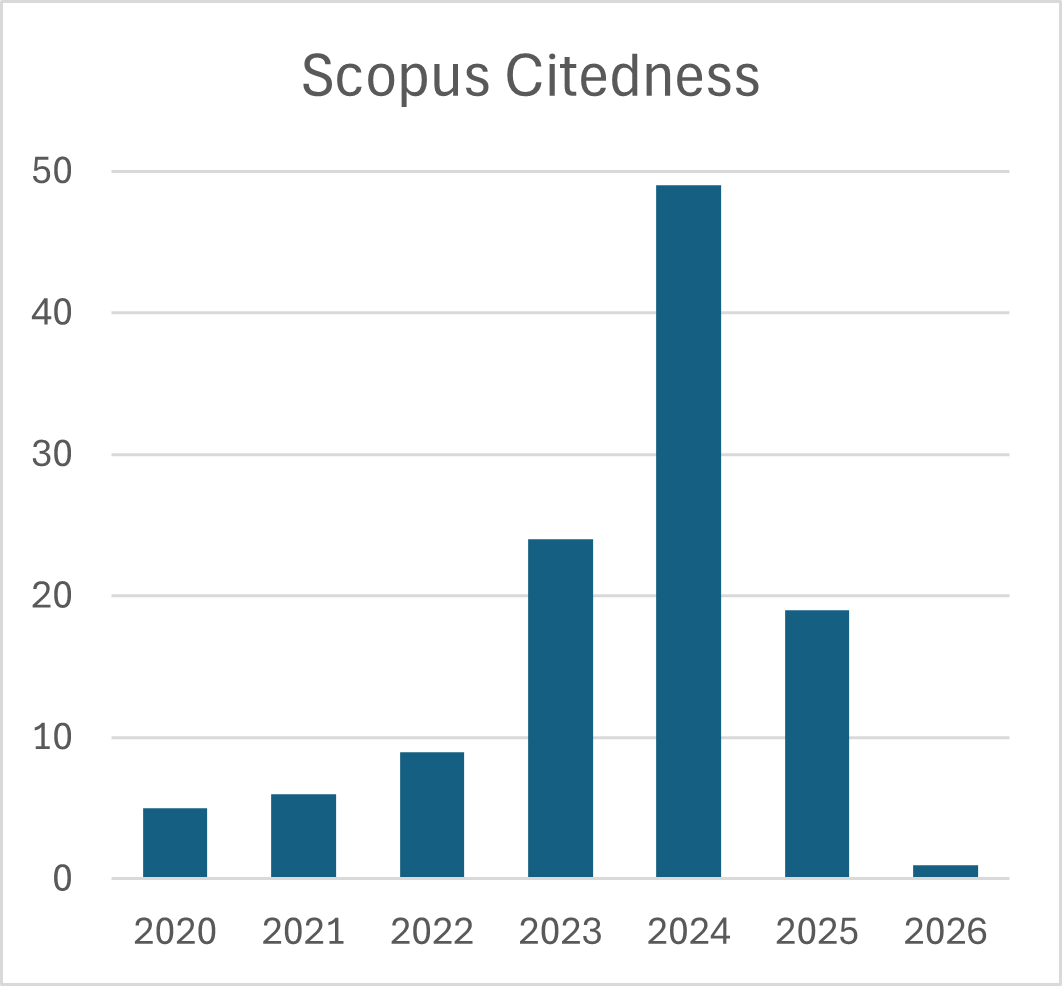A Hybrid Control Chart-Taguchi Method for Control and Optimization of Safety Conformity
DOI:
https://doi.org/10.24002/ijieem.v2i2.3783Keywords:
Taguchi method, control chart, orthogonal array, bottling plant.Abstract
In this paper, a hybrid control chart-Taguchi method (CCTM) is proposed to solve the control and optimization problem regarding safety conformity parameters for a bottling process plant (BPP). The CCTM fuses the conservative control charts, which monitor the safety conformity parameters to promote and maintain the uppermost grade of employees’ physical, social and mental well-being. The control chart result is placed in the Taguchi methodical phase of factor-level determination to cultivate an orthogonal array. Then, the inventive rational ability of the control chart is used to correct the process and hence, enhances the Taguchi method. Consequently, the CCTM can be intensely robust and statistically precise. The proposed CCTM was successfully used to solve the safety conformity problem involving the control and parametric optimization in a bottling process plant. The field data uncovers the ability of the proposed CCTM to control and optimize the bottling process plant parameters. Moreover, it showcases the results as better than an enormously stronger than the conventional Taguchi method.
References
Abdellah, A., Noordin, M.I., & Ismail, W.A.W. (2015). Importance and globalization status of good manufacturing practice (GMP) requirements for pharmaceutical excipients. Saudi Pharmaceutical Journal, 23(1), 9-13.
Alhrathi, A.A., & Yang, Q. (2014). Application of Taguchi method in health and safety fire extinguishing experiment. International Journal of Engineering Research and Applications, 4(5), 37-44.
Ansary, M.A., & Barna, U. (2015). Workplace compliance of RMG industry in Bangladesh: Structural assessment of RMG factory buildings. International Journal of Disaster Risk Reduction, 14, 424-437.
Ayomoh, M.K.O., & Oke, S.A. (2006). A framework for measuring safety levels for production environments. Safety Science, 44, 221-239.
Azadeh, A., & Sheikhalishahi, M. (2015). An efficient Taguchi approach for the performance optimization of health, safety, environment, and ergonomics in generation companies. Safety and Health at Work, 6(2), 77-84.
Baldissone, G., Comberti, L., Bosca, S., & Murè, S. (2019). The analysis and management of unsafe acts and unsafe conditions: Data collection and analysis. Safety Science, 119, 240-251.
Bobbili, R., & Madhu, V. (2016). Sliding mean behaviour of E-glass-epoxy/MWCNT composites: An experimental assessment. Engineering Science and Technology, an International Journal, 19(1), 8-14.
Brhlikova, P., Harper, I., Subedi, M., Bhattarai, S., Rawal, N., & Pollock, A.M. (2015). Aid conditionalities, international good manufacturing practice standards, and local production rights: a case study of local production in Nepal. Global Health, 11(25), 1-10.
Cheng, S.Y., Lin, K.P., Liou, Y.W., Hsiao, C.H., & Liu, Y.J. (2019). Constructing an active health and safety performance questionnaire in the food manufacturing industry. International Journal of Occupational Safety and Ergonomics, 27(2), 1-21.
Dźwiarek, M., & Latała, A. (2016). Analysis of occupational accidents: prevention through the use of additional technical safety measures for machinery. International Journal of Occupational Safety and Ergonomics, 22(2), 186-192.
Diaz, Y.F., & Resmick, M.L. (2000). A model to predict employee compliance with employee corporate’s safety regulations factoring risk perception. Proceedings of the Human Factors and Ergonomics Society Annual Meeting, 44(27), 323-326.
Geraci, C.L., Tinkle, S.S., Brenner, S.A., Hodson, L.L., Pomeroy-Carter, C.A., & Neu-Baker, N. (2018). Launching the dialogue: Safety and innovation as partners for success in advanced manufacturing. Journal of Occupational and Environmental Hygiene, 15(6), D45-D50.
Gressgard, L.J. (2014). Knowledge management and safety compliance in a high-risk distributed organisation system. Safety and Health at Work, 5, 53-59.
Grob, K., Stocker, J., & Colwell, R. (2009). Assurance of compliance within the production chain of food contact materials by good manufacturing practice and documentation – Part 1: Legal background in Europe and compliance challenges. Food Control, 20(5), 476-482.
Grob, K., & Marmiroli, G. (2009). Assurance of compliance within the production chain of food contact materials by good manufacturing practice and documentation – Part 3: Lids for glass jars as an example. Food Control, 20(5), 491-500.
Hong, C.C., Ramayah, T., & Subramaniam, C. (2018). The relationship between critical success factors, internal control, and safety performance in the Malaysian manufacturing sector. Safety Science, 104, 179-188.
Kalashnikov, A., & Sakrutina, E. (2019). Safety management system and significant plants of critical information infrastructure. IFAC-PapersOnLine, 52(13), 1391-1396.
Landi, L., Amici, D., Boldrini, O.A., & Germani, E. (2018). Sheets impact simulation for safety guards design: experiments and correlation for FE Explicit models of non-alloy steel. Procedia Structural Integrity, 8, 3-13.
Li, F., Jiang, L., Yao, X., & Li, Y. (2013). Job demands, job resources, and safety outcomes: The role of emotional exhaustion and safety compliance. Accident Analysis and Prevention, 51, 243-251.
Lüken, K., Pardon, H., & Windemuth, D. (2006). Bypassing and defeating protective devices of machines – a multidimensional problem. INRS – Hygiene et securite du travail, 4(205), 55-58.
Mewes, D., Mewes, O., & Herbst, P. (2011). Impact resistance of guards on grinding machines. International Journal of Occupational Safety and Ergonomics, 17(4), 411-421.
Martins, S.A., & Oke, S.A. (2020). Safety conformity prediction for a bottling process plant: using multiple regression analysis for enhanced safety performance, Kufa Journal of Engineering, 11(2), 28-48.
Manjunath, G.B., Bharath, K, N., Ganesh, D.B., Rajkamar, D.G., Shivprakash, P., & Harsha, H.M. (2017). ANOVA and response surface methodology for the optimization of fracture toughness parameters on jute fabric-epoxy composites using SENB specimens. Materials Today: Proceedings, 4, 11285-11291.
Oke, S.A., Johnson A.O., & Omogoroye O.O. (2005). A neurofuzzy theoretic approach to safety control at crude oil exploration platforms. Disaster Prevention and Management: An International Journal, 14(4), 454-461.
Oke, S.A., Charles-Owaba, O.E., Johnson, A.O., & Omogoroye, O.O. (2006). A fuzzy safety control framework for oil platforms. International Journal of Quality and Reliability Management, 23(5), 564-582.
Parker, D.L., Yamin, S.C., Brosseau, L.M., Xi, M., Gordon, R., Most, I.G., & Stanley, R. (2015a). National machine guarding program: Part 1, Machine safe-guarding practices in small metal fabrication businesses. American Journal of Industrial Medicine, 58, 1174-1183.
Parker, D.L., Yamin, S.C., Brosseau, L.M., Xi, M., Gordon, R., Most, I.G., & Stanley, R. (2015b). National machine guarding program: Part 2. Safety management in small metal fabrication enterprises. American Journal of Industrial Medicine, 58, 1184-1193.
Papic, L., & Pantelic, M., (2014). Maintenance oriented safety control charts, International Journal of System Assurance Engineering and Management, 5(2), 149-154.
Pichard, R., Philippot, A., & Riera, B. (2017). Consistency checking of safety constraints for manufacturing systems with graph analysis. IFAC Proceedings, 50(1), 1193-1198.
Riera, B., Coupat, R., Philippot, A., Annebique, D., & Gellot, F. (2014). Control design pattern based on safety logical constraints for manufacturing systems: application to a palletizer, IFAC Proceedings, 47(2), 388-393.
Ruff, T.I., Coleman, P., & Martini, L., (2011). Machine-related injuries in the US mining industry and priorities for safety research. International Journal of Injury Control and Safety Promotion, 18(1), 11-20.
Schuh-Renner, A., Camelio, J., & Woodall, W.H. (2013). Control charts for accident frequency: A motivation for real-time occupational safety monitoring. International Journal of Injury Control and Safety Promotion, 21(2).
Sii, H.S., Ruxton, T. & Wang, J. (2001). Taguchi concepts and their applications in marine and offshore safety studies. Journal of Engineering Design, 12(4), 331-358.
Uzor, U., & Oke, S.A., (2018). A model to predict and optimize machine guarding operator compliance activities in a bottling process plant: A developing country experience. International Journal of Occupational Safety and Ergonomics, 26(9), 1-37.
Vukicevic, A.M., Djapan, M., Stefanovic, M., & Macuzic, I. (2019). SafE-Tag mobile: A novel javascript framework for real-time management of unsafe conditions and unsafe acts in SMEs. Safety Science, 120, 507-516.
Wikner, J., Hedvall, L., & Mattsson, S.A. (2019). Hierarchical adaptive control of safety buffers in manufacturing. IFAC-PapersOnLine, 52(13), 2626-2631.
Yamin, S., Parker, D., Brosseau, L., Gordon, B., & Xi, M. (2014). National machine guarding program: Design of a machine safety intervention. Safety Science Monitor, 18(1), 1-11.
Zin, S.M., & Ismail, F. (2012). Employers’ behavioural safety compliance factors towards occupational safety and health improvement in the construction industry. Procedia Social and Behavioural Sciences, 36, 742-751.








